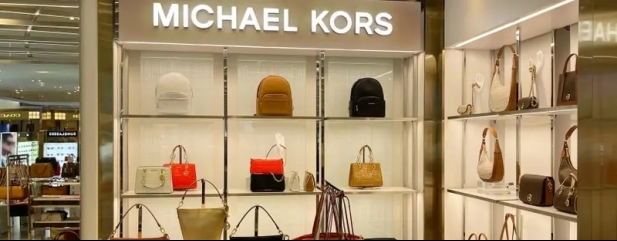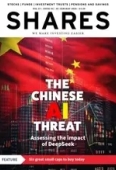Archived article
Please note that tax, investment, pension and ISA rules can change and the information and any views contained in this article may now be inaccurate.
Capri is a contrarian pick with identifiable upside catalysts in place

Capri Holdings (CPRI:NYSE) $24.93
Market cap: $2.94 billion
Risk-tolerant investors might want to take a look at Capri (CPRI), the global fashion luxury group behind iconic brands Versace, Michael Kors and Jimmy Choo.
Shares in the New York-listed company have plunged 50% in the past year after its planned $8.5 billion takeover by Tapestry (TPR:NYSE) was blocked by the FTC (Federal Trade Commission), leaving the shares looking cheap relative to history on around 15 times forward earnings.
Admittedly Capri’s plump debt pile is a concern, but there are a number of catalysts in place which could drive a re-rating of shares that have staged a mini rally year-to-date.
These include a return to positive revenue growth and sustainable profitability driven by a recovery in luxury spending, reduced risk as improving cash generation and brand disposals bolster the balance sheet, not to mention the possibility of another tilt at a company with fabulous brands, pricing power and attractive gross margins in the mid-sixty percent range.
WHAT IS CAPRI?
Capri is the parent company of brands including Michael Kors, Kors, Versace and Jimmy Choo, and designs and sells luxury clothing, shoes, watches, handbags and other high-end accessories.
In 2023, Coach New York-to-Kate Spade owner Tapestry offered to buy Capri for $8.5 billion or $57 a share, more than double the current stock price, in a planned affordable luxury combination that put Capri’s shares within touching distance of the $70 mark.
However, the stock cratered after the handbag makers’ combination was kiboshed by the regulator on anti-competition concerns, forcing Tapestry to abandon the deal late last year.
THREE ICONIC HOUSES
With management understandably distracted by the ill-fated takeover and the global luxury industry seeing softer demand, Capri is on a losing run of quarterly sales declines.
Disappointing second-quarter results on 7 November revealed a 16.4% top-line drop to below $1.1 billion, although chief executive John D. Idol was at pains to point out that: ‘Versace, Jimmy Choo and Michael Kors continued to resonate with consumers as evidenced by the 10.9 million new consumers added across our databases, representing 13% growth versus last year. This reflects the strong brand equity and enduring value of our three iconic houses.’
Market expectations ahead of results (5 February) for the third quarter including Christmas are subdued, which is a favourable set-up since any sign of a demand uptick should be met with a positive reception by the market.
Recent results from luxury rivals Richemont (CFR:SWX) and Burberry (BRBY) proved better-than-feared and indicated an overall improvement in luxury demand, with Burberry’s comparable store sales up 4% in the Americas.
CATALYSTS IN PLACE
BMO Capital Markets retail analyst Simeon Siegel recently upgraded Capri to an ‘outperform’ rating with a $31 target price, arguing the bears are too negative on the stock. ‘Capri deserves management and investor focus,’ wrote Siegel in a research note. ‘It’s regained the former; the latter should follow.’
Idol has personally taken the reins as chief executive of Michael Kors, the jewel in the Capri crown and the group’s largest brand.
A turnaround of Michael Kors will take time, but retail sage Siegel believes Capri has multiple ways to improve sentiment and share price performance alike. ‘While we don’t see clear signs of strength/inflection – yet - we see potential upside as sales, margins and debt pressures turn “less-bad”,’ he explained.
Media reports suggest Capri is preparing to sell Versace, with Prada (1913:HKG) mulling a potential acquisition, and gearing up to offload Jimmy Choo, disposals that would bring in bumper proceeds, help Capri reduce leverage and free up cash for reinvestment in the Michael Kors label.
BMO’s Siegel argues that the shortest path to share price upside is a reduction in that problematic debt load; net debt stood at $1.5 billion at the end of the second quarter, but is forecast to shrink to $1.2 billion by Capri’s financial year end.
‘Whether via asset sales or cash flow from business improvement, shrinking the market cap to enterprise value gap could represent meaningful and underappreciated upside to shares,’ enthused Siegel in his note.
Also relevant is that the new occupant of the White House, Donald Trump, loves a deal, and his administration is expected to take a more lenient stance on competition considerations than the anti-business Biden government, so any future bid for Capri could be looked upon more favourably by the FTC.
Important information:
These articles are provided by Shares magazine which is published by AJ Bell Media, a part of AJ Bell. Shares is not written by AJ Bell.
Shares is provided for your general information and use and is not a personal recommendation to invest. It is not intended to be relied upon by you in making or not making any investment decisions. The investments referred to in these articles will not be suitable for all investors. If in doubt please seek appropriate independent financial advice.
Investors acting on the information in these articles do so at their own risk and AJ Bell Media and its staff do not accept liability for losses suffered by investors as a result of their investment decisions.
Issue contents
Dan Coatsworth
Feature
Great Ideas
Investment Trusts
My Portfolio
News
- Everyman Media plumbs the depths after registering all-time low
- Will Diageo shareholders be raising their glasses or downing their sorrows?
- Can Palantir keep the plates spinning as its valuation balloons?
- WH Smith hangs ‘for sale’ sign over historic High Street stores
- Sage Group hits new high after 2024 results and buyback spur gains
- US technology stocks tumble on surprise Chinese AI innovation
 magazine
magazine








